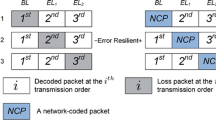Abstract
In multi-user video (MUV) delivery scenarios, the available resources of receiver devices, such as processing capability, link packet error rate (PER), and bandwidth, are usually different. We propose a relay-assisted hierarchical adaptation (RHA) scheme to maximize the total perceptual quality of all users when transmitting video streams coded via scalable video coding (SVC). First, MUV bitstreams are adaptively extracted under the constraints of network bandwidth and individual decoding capacity. Next, the relay links are introduced as substitutes of possible bad direct links for packets retransmissions. Approximately equal opportunity of transmission is allocated to each stream while the packets inside a stream are scheduled according to their priorities. The priorities are determined by the links states and packets loss distortions. Simulation results show that our RHA scheme has significant performance improvements compared with other schemes.
Similar content being viewed by others
References
Hsu J, van der Schaar M. Cross-layer design and analysis of multiuser wireless video streaming over 802.11e. IEEE Signal Proc Let, 2009, 16: 268–271
Maani E, Pahalawatta P V, Berry R, et al. Resource allocation for downlink multiuser video transmission over wireless lossy networks. IEEE Trans Image Process, 2008, 17: 1663–1671
Su G, Han Z, Wu M, et al. A scalable multiuser framework for video over OFDM networks: fairness and efficiency. IEEE Trans Circ Syst Vid, 2006, 16: 1217–1231
Li F, Liu G, He L. Cross-layer scheduling for multiuser H.264 video transmission over wireless networks. IET Commun, 2010, 4: 1012–1025
Zhu X, Agrawal P, Pal Singh J, et al. Rate allocation for multi-user video streaming over heterogeneous access networks. In: Proceedings of ACM Multimedia (MM’ 07). New York: Association for Computing Machinery, 2007. 37–46
Lu X, Wang Y, Erkip E, et al. Total power minimization for multiuser video communications over CDMA networks. IEEE Trans Circ Syst Vid, 2007, 17: 674–685
Shiang H, van der Schaar M. Multi-user video streaming over multi-hop wireless networks: a distributed, cross-layer approach based on priority queuing. IEEE J Sel Area Comm, 2007, 25: 770–785
Liu Y, Ma D. Multiuser scalable video streaming over Ad-Hoc wireless network with strict delay and energy constraints. In: Proceedings of International Conference on Wireless On-demand Network Systems and Services (WONS’ 2010). Piscataway: IEEE Press, 2010. 47–52
Mansour H, Krishnamurthy V, Nasiopoulos P. Channel aware multiuser scalable video streaming over lossy under-provisioned channels: modeling and analysis. IEEE Trans Multimedia, 2008, 10: 1366–1381
Laneman J N, Tse D N C, Wornell G W. Cooperative diversity in wireless networks: efficient protocols and outage behavior. IEEE Trans Inform Theory, 2004, 50: 3062–3080
Alcaraz J J, Garcia-Haro J. Performance of single-relay cooperative ARQ retransmission strategies. IEEE Commun Lett, 2009, 13: 121–123
Schwarz H, Marpe D, Wiegand T. Overview of the scalable video coding extension of the H.264/AVC standard. IEEE Trans Circ Systr Vid, 2007, 17: 1103–1120
Hu J, Choudhury S, Gibson J. PSNRr,j-MOSr: an easy-to-compute multiuser perceptual video quality measure. In: Proceedings of International Conference on Quality of Multimedia Experience (QoMEX’ 2009). Piscataway: IEEE Press, 2009. 116–120
Ou Y, Ma Z, Wang Y. A novel quality metric for compressed video considering both frame rate and quantization artifacts. IEEE Trans Circ Syst Vid, 2011, 21: 286–298
Ma Z, Wang Y. Complexity modeling of scalable video decoding. In: Proceedings of International Conference on Acoust, Speech, Signal Processing (ICASSP’ 08). Piscataway: IEEE Press, 2008. 1125–1128
Wah B W, Wu Z. The theory of discrete Lagrange multipliers for nonlinear discrete optimization. LNCS, 1999, 1713: 28–42
Joint Scalable Video Model (JSVM). JSVM Software, Joint Video Team, Doc. JVT-X203. Geneva, 2007
Intel VTune performance analyzer. Available at: http://software.intel.com/en-us/intel-vtune/
Author information
Authors and Affiliations
Corresponding author
Rights and permissions
About this article
Cite this article
Xiao, H., Ji, X. & Dai, Q. Relay-assisted hierarchical adaptation scheme for multi-user scalable video delivery to heterogeneous mobile devices. Sci. China Inf. Sci. 55, 1541–1550 (2012). https://doi.org/10.1007/s11432-012-4592-9
Received:
Accepted:
Published:
Issue Date:
DOI: https://doi.org/10.1007/s11432-012-4592-9




